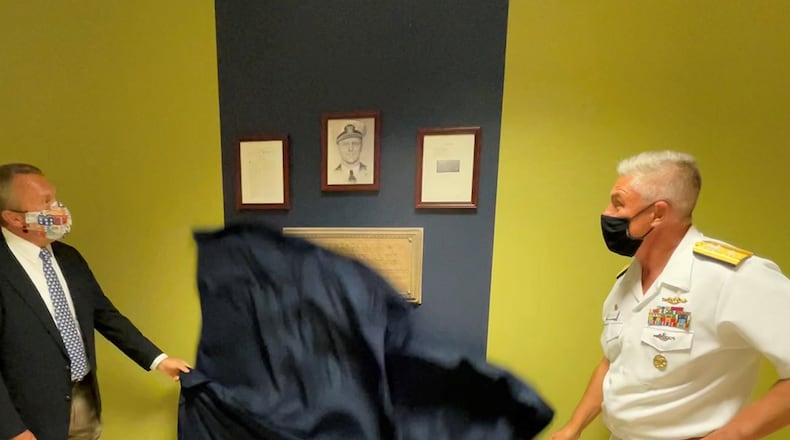“Aeromedical research in the Navy started as soon as we first took to the air, concentrating initially on fitness to fly,” said U.S. Navy Capt. Walter W. Daltisch III, NAMRU-D commanding officer. “Commander Liljencrantz was an early pioneer in the effects of acceleration in flight, the effects of which we are still researching today – so his legacy lives on.”
Liljencrantz was born in 1902 in Oakland, California, and completed his medical training at Stanford in 1929. According to his biography, he was the first medical director of the Pacific Division of the Pan-American Airways and joined the Naval Reserves in 1931. He was called to active duty in 1940 and was testing an accelerometer in a OS2U seaplane when the aircraft crash landed.
Just prior to his death he as slated to serve as the director of the proposed Aeromedical Research Laboratory, the predecessor to the Command’s Naval Aerospace Medical Research Laboratory.
The opportunity to highlight the legacy and memory of Liljencrantz while the Navy executed the Navy Week Dayton initiative was fortuitous. Spencer, a Fairborn native and lead flag officer for Dayton event, was offered an opportunity to tour the command and observe the unveiling of the plaque.
The admiral was provided with background information prior to the event and did some preliminary research where he learned about Liljencrantz’ significant impact on aeromedical research and his continuing impact on the aerospace medical community.
“The commander was a fascinating person,” Spencer said. “He authored one of the first early papers on what the physical attributes required for pilots. From what I understand, that was foundational for many years, (this was critical) for how we select folks to be pilots. That feels a lot of what (NAMRU-D) does every day.”
The plaque was originally featured at NAMRU-D’s Naval Aerospace Medical Research Laboratory at Pensacola Naval Air Station until recently. NAMRL’s current director, Dr. Richard Arnold, was given the plaque recently on as recent visit to Pensacola NAS to retrieve materials associated with the laboratory while it was still active there.
NAMRL moved to Wright-Patterson in 2010 as part of a Base Re-alignment and Closure decision to join the Navy’s Environmental Health Effects Laboratory, which was already located at Wright-Patt, subsequently becoming the Naval Medical Research Unit – Dayton.
Wuesthoff, who, like his grandfather, entered the military and immediately began a career devoted to aerospace, was an Air Force pilot who retired in 2008. The general accumulated more than 3,500 flying hours in the KC-135, KC-10, T-37 and C-5 aircraft with experience as a squadron, group and wing commander as well as senior joint positions. He was invited by Daltisch to participate and addressed the crowd prior to taking part in the unveiling.
“I’m left with a few questions about Eric,” he said. “Why the fascination with aviation? And I guess it began with the Wright Brothers, World War I, and then the barnstormers, so there was this fascination across the nation. Flying KC-10s out of Southern California, I would fly through Honolulu, and I would fly through Wake, I would fly through Guam, and all over Southeast Asia, and would still see some of those (old) Terminals that were still functional and I would imagine I was walking through my grandfather’s footsteps – it was fascinating to think about.”
The event also featured a guided tour of the command’s laboratories – NAMRL and the Environmental Health Effects Laboratory, which has been at WPAFB since 1972.
Navy Week Dayton is a weeklong public outreach event conducted by the Navy’s Office of Civic Engagement. The week aims to raise awareness of the Navy’s mission and presence in the local area while also demonstrating the unique capabilities of the Department of Defense’s seaborne service. Navy Week Dayton was July 26-31 and culminated with a series of performances by the Navy’s aerial demonstration team, The Blue Angels, July 30-31 at the Dayton Air Show.
NAMRU-D is a major Department of Defense medical research command and the home of the Naval Aerospace Medical Research Laboratory and the Environmental Health Effects Laboratory. As a subordinate command to the Naval Medical Research Center, NAMRU-D optimizes the readiness, performance, and survivability of operational forces through environmental health effects, toxicology and aerospace medical research and development.
About the Author

